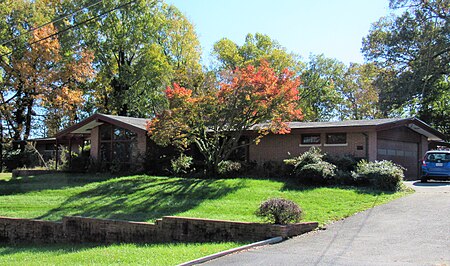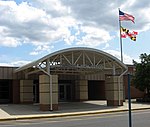Marenka House

The Marenka House is a historic house at 7300 Radcliffe Drive in College Park, Maryland. Built in 1958, it is a distinctive local example of Modern Movement architecture. It is a single-story brick structure in a basically rectangular form, with a broad low-pitch gabled roof. It has projecting gable sections to the north and south, and an integrated garage. The front projecting gable has floor-to-ceiling windows in its center, and a deep projecting eave. Although its architect is unknown, it is considered one of the area's finest Mid-Century Modern houses, an application of Frank Lloyd Wright's principles of organic architecture.The house was listed on the National Register of Historic Places in 2017.
Excerpt from the Wikipedia article Marenka House (License: CC BY-SA 3.0, Authors, Images).Marenka House
Radcliffe Drive, College Park Yarrow
Geographical coordinates (GPS) Address External links Nearby Places Show on map
Geographical coordinates (GPS)
| Latitude | Longitude |
|---|---|
| N 38.976111111111 ° | E -76.913888888889 ° |
Address
Radcliffe Drive 7300
20740 College Park, Yarrow
Maryland, United States
Open on Google Maps






